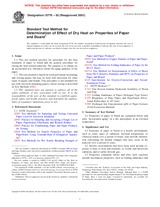Wir benötigen Ihre Einwilligung zur Verwendung der einzelnen Daten, damit Sie unter anderem Informationen zu Ihren Interessen einsehen können. Klicken Sie auf "OK", um Ihre Zustimmung zu erteilen.
ASTM D776-92(2001)
Standard Test Method for Determination of Effect of Dry Heat on Properties of Paper and Board (Withdrawn 2009)
Automatische name übersetzung:
Standard Test Methode zur Bestimmung der Wirkung von Dry Heat auf Eigenschaften von Papier und Pappe (Withdrawn 2009)
NORM herausgegeben am 15.9.1992
Informationen über die Norm:
Bezeichnung normen: ASTM D776-92(2001)
Anmerkung: UNGÜLTIG
Ausgabedatum normen: 15.9.1992
SKU: NS-39079
Zahl der Seiten: 3
Gewicht ca.: 9 g (0.02 Pfund)
Land: Amerikanische technische Norm
Kategorie: Technische Normen ASTM
Die Annotation des Normtextes ASTM D776-92(2001) :
Keywords:
accelerated aging, aging qualitied, dry heat, paperboard, ICS Number Code 85.060 (Paper and board)
Ergänzende Informationen
| Significance and Use | ||||||||||||||||||||
|
Exposure of paper or board to a hostile environment, such as some types of radiation, elevated temperature, or chemical attack over a period of hours, may provide information concerning the natural changes that may occur in the material over a period of years. Hostile environments that have been used include exposure to heat, to heat and moisture, to visible and ultraviolet radiation, and to sulfur dioxide gas. Properties compared before and after such exposure include mechanical properties, such as folding endurance and tearing resistance, optical properties such as brightness and opacity, and chemical properties such as pH and alkali resistance. For additional information, see Test Methods D 828, D 829, D 919, D 2176, TAPPI Methods T 509, T 212, T 423, and T 425. For determining the effect of moist heat treatment on paper see Test Method D 4714. It has been determined that the degradation of cellulose is very sensitive to moisture.5 ,6 Comparison of accelerated aging with natural aging indicates that some moisture should be present in an accelerated aging atmosphere.7 Dry accelerated aging of cellulose is much less sensitive and probably does not rank papers in order of stability as accurately as moist accelerated aging. Dry aging is much simpler to use and may be adequate for many purposes, but moist accelerated aging should be used where the greatest correlation with natural aging is needed. |
||||||||||||||||||||
| 1. Scope | ||||||||||||||||||||
|
1.1 This test method specifies the procedure for dry heat treatment of paper or board and the general procedure for testing the heat-treated materials. The purpose is to obtain, by an accelerated test, inferences about the aging qualities of the paper. 1.2 This test method is based on work performed on printing and writing papers but may be used with discretion for other types of papers and boards. This procedure is not intended for use with electrical insulating papers, whose testing is described in Test Methods D202. 1.3 This standard does not purport to address all of the safety problems, if any, associated with its use. It is the responsibility of the user of this standard to establish appropriate safety and health practices and determine the applicability of regulatory limitations prior to use. |
||||||||||||||||||||
| 2. Referenced Documents | ||||||||||||||||||||
|
Empfehlungen:
Aktualisierung der technischen Normen
Wollen Sie sich sicher sein, dass Sie nur die gültigen technischen Normen verwenden?
Wir bieten Ihnen eine Lösung, die Ihnen eine Monatsübersicht über die Aktualität der von Ihnen angewandten Normen sicher stellt.
Brauchen Sie mehr Informationen? Sehen Sie sich diese Seite an.




 Cookies
Cookies
